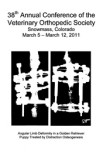Objective: The aim of this study was to evaluate the stress changes in the radii beneath the locking plates (LP) of dogs implanted with LP using finite element analysis (FEA).
Study design: The study included radii harvested from eight dogs. After computed tomography (CT) scans of the forelimb, the articular surface of the radius was fixed using resin. Material tests were conducted to identify the yield and fracture points and for verification with FEA. The CT data of the radius were imported into FEA software. The radii were classified into three groups based on the placement of the LP (nonplate placement, intact group; 1 mm above the radial surface, LP + 1 mm group; 3 mm above the radial surface, LP + 3 mm group). Equivalent, maximum, and minimum principal stresses and minimum principal strain were measured after FEA at the radial diaphysis beneath the plate.
Results: In shell elements, the LP + 1 mm and LP + 3 mm groups showed a significantly lower maximum principal stress compared with the intact group. In solid elements, the LP + 1 mm and LP + 3 mm groups showed a significantly higher equivalent stress and a significantly lower maximum principal stress compared with the intact group.
Conclusion: When an axial load is applied to the radius, LP placement reduces the tension stress on the cortical bone of the radius beneath the plate, possibly related to implant-induced osteoporosis and bone formation in the cortical bone beneath the plate.









